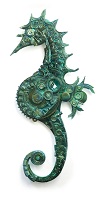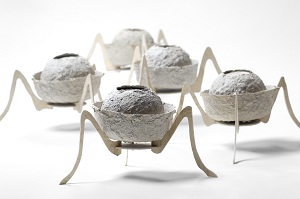By Hend Seif El Din
 the French-born artist was a leading figure in the Dada movement of the early 20th century, who strived to “kill the arts,” in their traditional sense. Duchamp, who coined the term “readymade” in 1915, used found, every day objects, in his works, which explains his use of a urinal to create one of his most iconic works titled “The Fountain” in 1917.
the French-born artist was a leading figure in the Dada movement of the early 20th century, who strived to “kill the arts,” in their traditional sense. Duchamp, who coined the term “readymade” in 1915, used found, every day objects, in his works, which explains his use of a urinal to create one of his most iconic works titled “The Fountain” in 1917.
 Back to our modern day “junk” or “trash” art. Undoubtedly, many of you who’ll come across any of the above terms will automatically label these art works…well…junk! Don’t limit yourself to clear-cut definitions and terms; the notion that trash has to be ugly or useless is a common fallacy that many of us still can’t get over.
Back to our modern day “junk” or “trash” art. Undoubtedly, many of you who’ll come across any of the above terms will automatically label these art works…well…junk! Don’t limit yourself to clear-cut definitions and terms; the notion that trash has to be ugly or useless is a common fallacy that many of us still can’t get over.
 Mind you, junk can be beautiful, if you have the imaginative eye to see it. Take a closer look at these artistic works, made of so-called “useless” or trash-like objects. You will soon notice that a lot of thought and effort has been put into junk sculptures and installations. Yes, they are composed of found and reclaimed metals, paper, cardboard…and the list goes on, but so what? As a matter of fact, I would go so far as to say that they’re not junk at all. Sure, they don’t look as appealing or as pleasing as Michelangelo’s sculptures from the aesthetic point of view, but if you focus on the proportions and dimensions you’ll realize that it’s not as easy as it looks. Noticeably, “recycled art,” which is one of its many names, is growing in popularity especially in Europe–more and more artists are resorting to their trash cans to produce “beautiful” works of art. So where is the line between ugliness and beauty? Well…it seems that rules no longer apply, so it’s up to you to decide, but until then, try to enjoy the wonderful world of junk.
Mind you, junk can be beautiful, if you have the imaginative eye to see it. Take a closer look at these artistic works, made of so-called “useless” or trash-like objects. You will soon notice that a lot of thought and effort has been put into junk sculptures and installations. Yes, they are composed of found and reclaimed metals, paper, cardboard…and the list goes on, but so what? As a matter of fact, I would go so far as to say that they’re not junk at all. Sure, they don’t look as appealing or as pleasing as Michelangelo’s sculptures from the aesthetic point of view, but if you focus on the proportions and dimensions you’ll realize that it’s not as easy as it looks. Noticeably, “recycled art,” which is one of its many names, is growing in popularity especially in Europe–more and more artists are resorting to their trash cans to produce “beautiful” works of art. So where is the line between ugliness and beauty? Well…it seems that rules no longer apply, so it’s up to you to decide, but until then, try to enjoy the wonderful world of junk.



